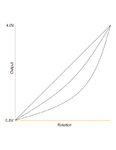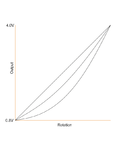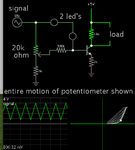Altair2
Newbie level 4
Hi everyone,
I have an e-bike on which the throttle handle is based on a Hall effect sensor, with an output that varies between 0.8V-4.0V depending on rotation of the handle.
I would like to have a more logarithmic output curve from the sensor, instead of the roughly linear curve.
I have designed a circuit that takes advantage of the non-linearity of a PN junction to pull down my curve, but this type of circuit is not temperature-stable, and also not variable in its effect, meaning that I cannot adjust my curve fron linear to logarithmic without modifying the circuit.
So the reason of my visit here is to gather ideas as to how I could accomplish such a thing.
A few of the ways to attain that goal could be for example, go digitally with a read-out table, and then use a balance pot to smoothly select between both extremes.
Or use a log amplifier...
Or use a FET as a variable resistor to pull the output voltage down when it is low, let it rise when it is higher, everything being just a balance of resistors affecting the impedance of the signal line. Or use a VCA chip instead of the FET.
I would like to find a simple solution, I don't need precision, just that the maximum and the minimum voltages be the same as what comes out of the Hall sensor. And that it be adjustable with a single pot.
What do you think? Am I looking for the imposible?
Maybe a simpler solution would be to change the Hall throttle to a resistive potentiometer-based one, and add a pot between wiper and ground, which allows a nice (and adjustable) pulling down of the curve.;-)

I have an e-bike on which the throttle handle is based on a Hall effect sensor, with an output that varies between 0.8V-4.0V depending on rotation of the handle.
I would like to have a more logarithmic output curve from the sensor, instead of the roughly linear curve.
I have designed a circuit that takes advantage of the non-linearity of a PN junction to pull down my curve, but this type of circuit is not temperature-stable, and also not variable in its effect, meaning that I cannot adjust my curve fron linear to logarithmic without modifying the circuit.
So the reason of my visit here is to gather ideas as to how I could accomplish such a thing.
A few of the ways to attain that goal could be for example, go digitally with a read-out table, and then use a balance pot to smoothly select between both extremes.
Or use a log amplifier...
Or use a FET as a variable resistor to pull the output voltage down when it is low, let it rise when it is higher, everything being just a balance of resistors affecting the impedance of the signal line. Or use a VCA chip instead of the FET.
I would like to find a simple solution, I don't need precision, just that the maximum and the minimum voltages be the same as what comes out of the Hall sensor. And that it be adjustable with a single pot.
What do you think? Am I looking for the imposible?
Maybe a simpler solution would be to change the Hall throttle to a resistive potentiometer-based one, and add a pot between wiper and ground, which allows a nice (and adjustable) pulling down of the curve.;-)



